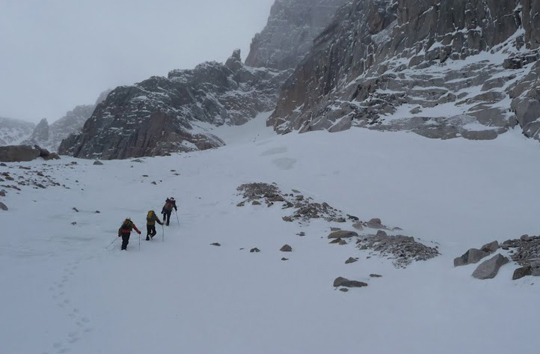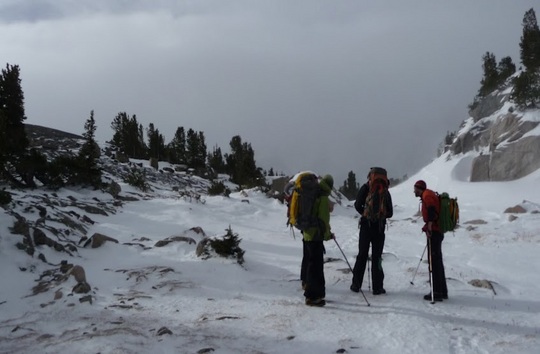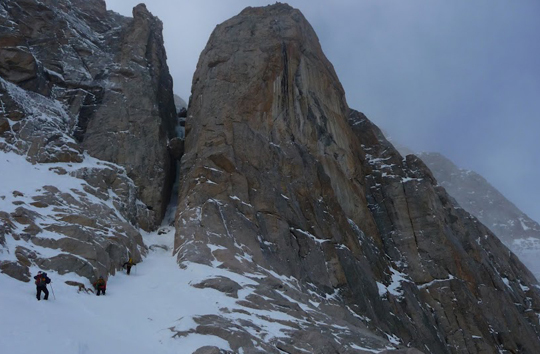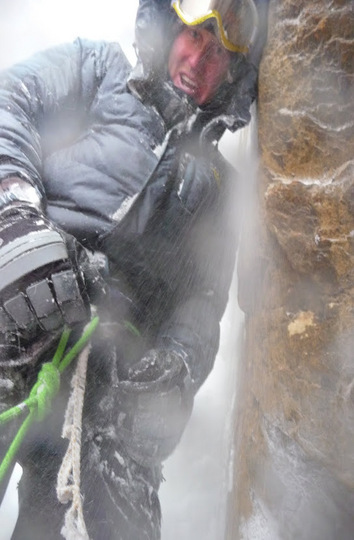
[Photo] Pete Tapley
The Buddha himself on Dukkha:
Birth is Dukkha, aging is Dukkha, death is Dukkha; sorrow, lamentation, pain, grief, & despair are Dukkha; association with the unbeloved is Dukkha; separation from the loved is Dukkha; not getting what is wanted is Dukkha. In short, the five clinging-aggregates are Dukkha.
October: low stoke; a wasted body and a troubled mind. Beartooth Mountains, Montana: cold stone and high winds. Climbing has been on the back burner for a while; I’ve been preoccupied and jaded to boot, yet like any junky, there’s really no leaving the monkey behind–that bugger clings tight to my back and calls to me from the dusty corners of old ambition.
I swear it off, wish for new-found passion, woo myself convincingly that personal satisfaction in climbing now only comes from teaching and inspiring others–that I have moved past my proving days and I’m thankful for it, happy to be off the hook. Then, I hear the monkey shriek and feel its bite in my neck…a change of season, a hint of something ethereal on the wind, long shadows and dark mornings conspire to pull me back in, a la Pacino–just when I thought I was out.
And so goes the narrative of a dark and introverted alpinist, the story we know well of how personal suffering can be channeled into a proper meditative mindset, useful while facing dire circumstances and often resulting in a fine catharsis. At 4:30 a.m. however, such talk is minimal. With a carload of smelly guys, smelly gear and a lot of coffee, the talk is more peripheral. “What’s the latest forecast?” “I had no idea what to pack last night…” “Red sky in morning, sailors take warning.”

[Photo] Pete Tapley
We laughed and joked at our own absurdity, seeing the red dawn as we drove eastward and noting the black sky to the south where we would turn and gain elevation soon. “Hey, if you’re about to start your ice climbing season, you might as well do it right, huh?” Still below the surface laid the truth to our motives and hidden behind the goal of our chosen climb was our actual ambition. A gesture was made to the south and to that deep, dark cloud that engulfed the entire range, then lifted slightly over the valley and showed a massive collapse in pressure with stacks of lenticular clouds bearing down as the land mass rose again, “Look, it’s the wall of hate.” A one-word response was elicited: Dukkha.
And so it was that the word of the day was set and adopted, Dukkha, the oft-translated as “life is suffering” first noble truth. That’s what we were after. That’s what we wanted–a big fat dose of suffering by choice. I know I’d been craving it, that sweet cleansing that only the cold pain of alpine climbing in foul conditions has ever given me. Oh for those moments far from the world, safe in my microcosm of running grey and varying shades of cold white; for the clarity of mind found in pure action and intimate awareness of the immediate and the real; for those times of letting go, relaxing and focusing determination simultaneously. Just give me a fix, just one fix.
No sooner was it spoken than it was accepted, embraced: we wanted discomfort, we wanted adversity and the floodgates were now open–coffee onboard, harsh weather inbound, the season upon us and we could not wait a moment longer. The monkey eased its bite, climbed off my back and into my lap–we were on our way…

[Photo] Pete Tapley
At the trailhead, senses heightened and the wind cut through layers — the wall of hate was close.
There’s nothing quite like having a group of testosterone-filled twenty-somethings to combat the stoke-depleting effects of steady seventy-mile-an-hour winds and further the determination of my aging self. The wind knocked us sideways, backwards, forwards and unexpectedly every which way but down. We leaned into it, turned our backs to it, put on goggles and pressed onward, further into the black wall, knowing that what we wanted was there to be had. We took five in a tiny shack on top of a small dam near the base of our route and laughed heartily at the wind and its shaking effects on the scrappy little shelter. Concern finally showed in the face and voice of one: “do you guys always ice climb when it’s like this?” The answer came quickly and confidently: “only when it’s like this.” And then there were four…

[Photo] Pete Tapley
Closing my eyes, I can easily visualize the basin above the lake and feel the freezing spray of water being whipped airborne by gale-force winds: immaculate granite soaring in all directions, limitless possibilities for alpine endeavors left to the creative mind. Stepping out of the shack on the dam, my head spun with sensory overload –the wind, the stinging spray, the contrast of earth to sky and water to storm; the world outside was raging. Visibility was low and there were massive buttresses all around, but where was our intended line? I’d taken it for granted that we would walk up, see the line and amble toward it, but that was not the case. Conditions were overwhelming. We stole glances from beneath hoods drawn tight and narrowed down the selection–it had to be one of the two largest formations. We moved as quickly as possible to find the sheltered lee of a massive rock wall and escape the wind.

[Photo] Pete Tapley
More wind and slip-sliding across a small lake brought us to the line of sight we needed to confirm where we were going. Now, it was simply head-down slogging upslope to reach the start of the climbing — a perfect chimney with a massive and unmistakable chockstone verifying its authenticity as our intended line. The beautiful pink and tan granite ran deep and high up the mountainside, choked with dreamy ice deep-grey in color and running with modest spindrift. Ah, the Dukkha.
This was one of those routes that had been on my radar for ages, but I’d never gotten around to it. Now that I was at the base, I was set on sending. It was beautiful, it was perfect. We made analogies to routes in Alaska, ohh’d and ahh’d over this and that aspect of the climbing ahead, then lost a little enthusiasm as the spindrift continued.
There was little to no talk of what our rope teams would be, but the implication became apparent that both Loren and I were planning to lead. Scott and Kevin then partnered with us respectively and as a result of where we stood at the base. Time began to slip by without action and I became anxious…I was wanting to give Loren the lead, to pass the torch to this energetic and inspired youth (or perhaps to have him poodle out there and prep the route for me), but he wasn’t taking the bait and I could wait no longer. Every time a slough ran through the slot above I tingled with excitement–it would be cold; it would be dark; it would be frightful and soothing at once; it might be heavy, and if it was, it could be dangerous.
The wind howled near constantly and the sloughs coincided. There was nothing above to load and release, only miles of high, frozen plateau for the wind to rake hard and fast, scouring clean of any and all snow that may have accumulated, then funnel down our chosen line above–perfect. I was confident that there was little safety concern with these avalanches, only added Dukkha, free of cost. We were telling ourselves that the route just needed a few minutes to flush clean and that after that, we’d be in the clear. With one of the better lulls I seized the opportunity and launched upward, I had a vein and was plunging, but still needed that fix, needed it to hit me and hit me hard.
Continued in the video below